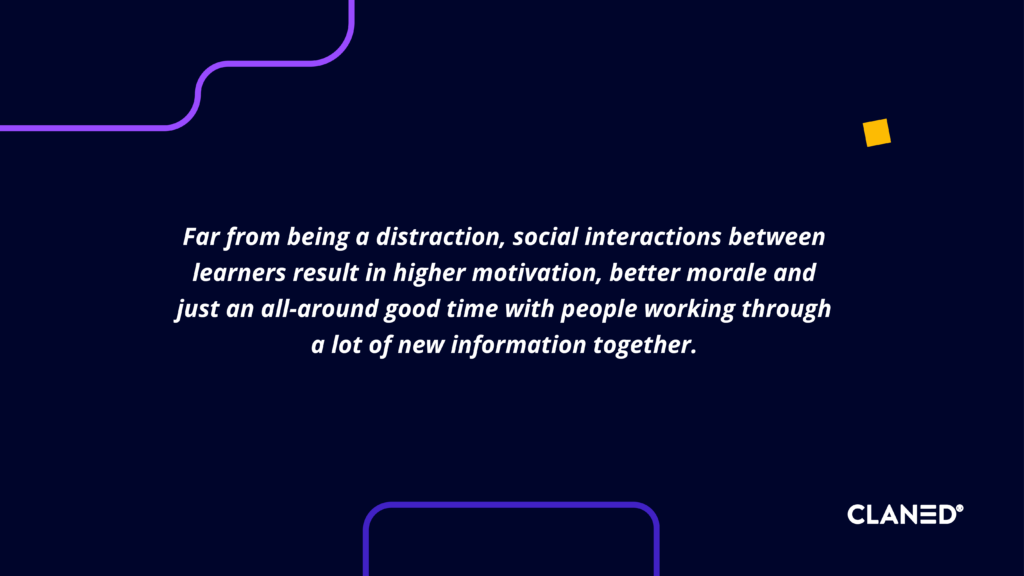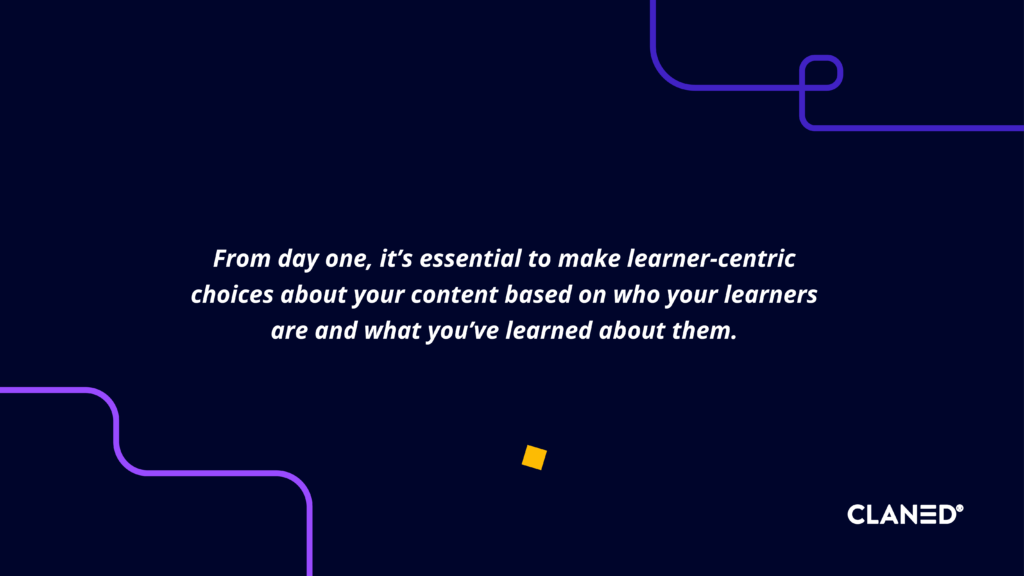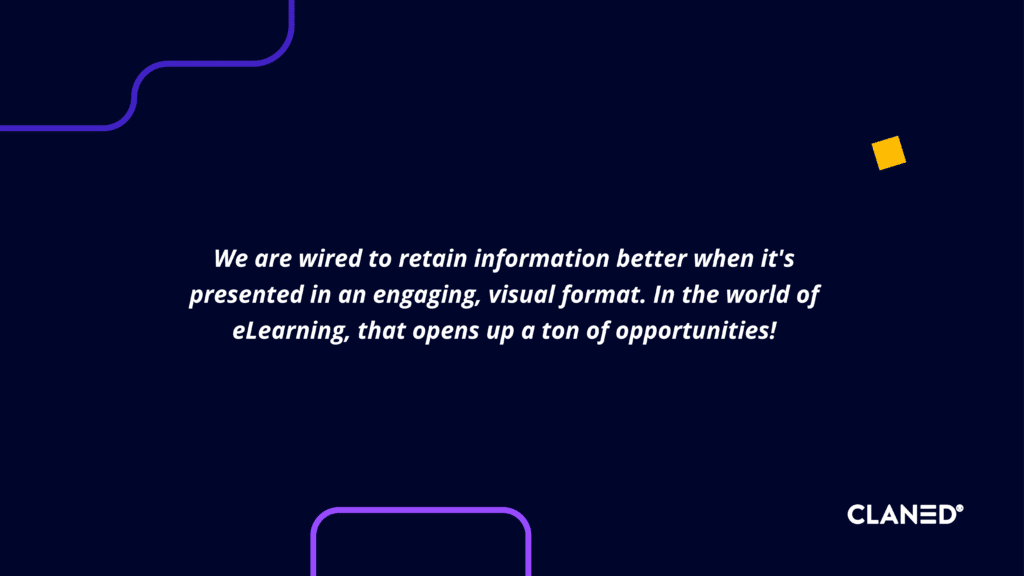Here’s a fun question: What’s a course builder’s worst nightmare?
Sure, the platform could glitch out. The content might not load properly. People might have a hard time accessing the course… all worthy contenders for the title of the “worst thing to happen to a course”.
But imagine everything going smoothly. All that hard work that was spent over weeks, even months, finally leading to a glorious, fully functional online course. Only for it to end up in a virtual classroom of a bored, yawning, sighing group of learners.
Well, there we have the winner: the absolute worst thing to happen to a course is unengaged, unmotivated learners.
As a course builder, nothing breaks your heart quite as much as finding out that your learners have absolutely no interest in the course experience. Not to mention all the time, effort and resources that you and your organisation has by that time lost in the effort.
But there are surefire ways to fix this problem before it even arises. For years, experts in education and pedagogy have sought to understand what makes a learner truly interested and invested in the learning process.
And as experts in online learning ourselves, we at Claned have our own set of best practices to help organisations create engaging online courses that keep learners coming back for more.
So what’s the big secret? Let’s find out!
Why Is It Important to Keep Learners Engaged in Online Learning?
To start with, let’s better understand the importance of getting learners engaged with your online courses. (Yes, even if participation in the course is mandatory for them).
Well, for starters, when you build more engaging online courses, you essentially set up your learners for success. There is a plethora of pedagogical research out there that shows a clear link between learner engagement and performance.
The more engaged your learners, the better they perform on your online courses and the likelier they are to retain information, internalise the knowledge and demonstrate the desired skills. It’s truly as simple as that.
But there’s more: engaged learners are great news for your organisation and its business outcomes too. When an online course manages to keep its learners engaged, the learners become more committed to completing the program and pass along their newly gained knowledge and skills to other members of the organisation.
Let’s not forget: successful learners always lead to successful courses. Which has got to be music to your ears after you put all that time, hard work and resources into your learning initiatives.
So all in all, everyone benefits from a course experience that is as interesting, exciting and engaging for the learners as possible. The learners get to go on a great learning journey and learn something worthwhile. And your business gets to reap handsome rewards for all its efforts. Engaging online courses are truly a win-win!
5 Ways to Make Online Learning More Engaging For Learners
And now, for the good stuff! Here are our top tips and practices for creating engaging online courses that will help you and your learners get the most out of the course experience.
#1. Plan It All Out: Goals, Content and Preferences
The most engaging courses can make the learning experience feel like a breeze. But make no mistake – creating a course that feels effortless requires a whole lot of effort. And at the heart of all that effort lies a master plan.
To create an engaging online course, it’s important to carefully plan out each step of your learning program – especially when it comes to online classrooms as they come with their own unique set of considerations and challenges.
Every choice your learner could make, every piece of content they could enjoy, every opportunity where they could explore a topic or have conversations with one another — elements like these are what make an online course worth taking part in! And it all starts with a plan:

- What are the Goals? It’s crucial to set clear, achievable goals not just for your organisation but also for your learners.
Remember: keeping learners on the right track becomes easier when they can see the path ahead. So make sure to first outline what you want the learners to know or be able to do by the end of the course in the form of micro- and macro-objectives. Then, clearly communicate these expectations throughout the course so your learners know exactly what they’re working towards.
- Content Based on Learner Preferences: At Claned, we talk a lot about the importance of doing learner research before building a course. And this is where all that information comes to shine!
When you make choices in content structure, format and delivery based on what you know about the learners, you create a learning space that is suited to their preferences. This means you don’t have to work as hard to keep them glued to the course – because they’ll enjoy sticking around themselves for the learning. (More on this later!)
Need a hand planning out your course? Check out our guide to building a complete online course using the tried-and-tested ADDIE model. Plus, a free template! ADDIE Model: 5 Steps to Effective Online Learning (Complete Guide With ADDIE Template)
#2. Give Learners a Say: Experience and Autonomy
Look, the truth is: in today’s time, anyone can create engaging online course. But if you want to keep learners truly invested in their own learning, you need to offer them an “experience”.
Your learners are likely to be intimately familiar with the online world, with a host of shopping apps, streaming services and social media platforms already a part of their daily digital diet. This means that they’ll be stepping into any online learning or training experience you create for them with certain expectations. As they should.
So if you want to make your online course engaging, your best bet is to build it on a modern, sleek and effective online learning platform that offers “the works”.
Of course, no two platforms are the same. But there are a few items you should look out for.
An intuitive platform experience is a must. As is the need for a vibrant digital space that allows learners to track progress, easily interact with the materials and communicate with each other. Offering your learners the convenience of accessing the course on different digital devices is helpful too because really, who doesn’t love that?
But choosing the right platform is easier said than done. So be sure to check out our guide for some useful tips: How to Choose a Learning Platform
With all that said, a big part of creating the ideal learning experience is also to give your learners the autonomy to explore the course and pursue learning on their own terms. Consider offering asynchronous learning options and additional information, resources and avenues that allow learners to discover and learn more throughout the course.
The rigid, traditionally structured form of learning we’ve been familiar with for decades is quickly going out of style. Meanwhile, a whole new world of opportunities grows in online learning every year.
So for you as the course-builder, here’s the key insight: Your learners are more likely to respond to your courses if you can meet them where they’re at. They’re more likely to engage with courses that understand their needs and limitations and offer them freedom and flexibility.
Which leads us to our next tip…
#3. Stay Connected: The Human Element
It’s so easy to get caught up in the technicalities and practicalities of course-building that we often lose sight of the big truth behind the screen: these courses are being created by humans, for humans!
Underneath all that jargon and terminology, there lies an intrinsic human need to connect, learn, and feel a sense of reward and accomplishment. And while it’s easier to evoke these feelings when we’re amongst humans in a traditional classroom, online learning programs need a little extra support.
Reward Success: There’s a reason your productivity app makes that satisfying ‘ting’ sound when you check an item off your list. As humans, we love being validated and rewarded for our achievements, no matter how small.
As a course builder, you can integrate this simple principle into your learning program by adding gamified elements as learners reach certain milestones, checkpoints, and achievements. Wherever possible, offer meaningful feedback and words of encouragement to let your learners know there are people rooting for their success on the other side of the screen.
Keep It Real: Learners are also more likely to engage with your online courses if they see parts of their own lives and experiences reflected in the course content. Don’t hesitate to use storytelling techniques, metaphors and humour. One great way is to put the learning in context by presenting situations or scenarios that the learners might be familiar with or are likely to encounter in the future.
Take it Live: Of course, in any learning environment, it also helps to have a friendly human face that learners could take their questions, doubts and hesitations to. Consider including live webinars and/or Q&A sessions where learners can virtually gather around a (human) instructor or trainer, get feedback and perhaps most importantly, feel heard and seen by a guiding figure.
To learn more about how to add human elements to your course, check out our in-depth article: How to Engage Learners with Human-Centered Design
#4. Build a Community: The Social Element
Another important rule for designing engaging online courses: don’t miss out on the opportunities that come with the incredible power of social learning!

Far from being a distraction, social interactions between learners result in higher motivation, better morale and just an all-around good time, where people feel a little less lonely as they make their way through a lot of new information together.
We cannot overstate this: Building and fostering an active course community is one of the best things you can do for the success of everyone involved – your course, your organisation and of course, the learners!
The course experience is made all the more engaging thanks to the vibrant interactions that can take place in chats and discussion boards. In the best of course communities, learners don’t just exchange comments – they share unique perspectives, informed opinions and fresh approaches to the course content. They even answer each other’s questions. All of which contribute greatly to the overall learning experience.
Depending on your learning platform, you could explore various social learning features that are designed to encourage learner discussions and foster communities. If possible, it’s a great idea to include a dedicated, interactive space within the course where learners can gather around and discuss individual topics and content pieces.
After all, there’s nothing quite as engaging as a really, really interesting discussion!
#5. Keep the Content Fresh
Alright, so it’s time to talk about the last (and some might say, the most crucial) ingredient of a truly engaging online course.
The truth is: you can work hard at perfecting all the things we’ve talked about so far – goals, learner experience, rewards, and community. And yet, all that hard work can be easily undone by the course content. Specifically, boring, unfocused, “I could be doing anything else with my time” content.
Have you ever had someone talk at you than with you? Not the most pleasant experience. The same principle applies to your content choices.
If the content in your course ever gives off the impression that it was written without the learners in mind, they are sure to be put off. And then they’re going to go looking for other, more engaging pursuits.
This is where we bring all of our efforts back to point #1 (i.e. planning your course out). From day one, it’s essential to make learner-centric choices about your content based on who your learners are and what you’ve learned about their needs, strengths and weaknesses, expectations, learning habits and learning styles.

Here are a few helpful tips for creating engaging course content:
- Content Diversity: No one likes monotony. So make sure to add a variety of content formats to always keep things interesting. PDFs, presentations, videos, audio recordings, VR – there are so many ways to learn and they can all be easily integrated into a multimedia online course experience.
- Keep it Short and Simple: There’s only so much new information we can take in at any given time before a certain fatigue sets in. So go easy on your learners by keeping the individual chapters or modules short, no matter the overall course length. Moreover, make sure to convey the information in language that is simple, clear, straightforward and free of fluff or unnecessary jargon.
- Explore Visual Learning: There’s no doubt that texts are a classic, traditional form of learning that has stood the test of time. But as humans, we are wired to retain information better when it’s presented in an engaging, visual format. And in the world of eLearning, that means unlocking a whole world of opportunities!

So explore different opportunities to include infographics, charts, PPTs and a host of other visual forms of learning and storytelling to keep learners. And when it comes to videos, you’d be surprised at how many ways there are to present your information.
Here’s a simple guide to making a wide variety of videos for your online courses: How to Make Videos for Online Courses
Final Thoughts: It’s All About the Learners
There is so much thought that goes into choosing each element of an online course – from the platform to the content to the delivery, every single decision has a part to play in the final product.
But occasionally, we forget about the most critical element of all: the learners. To create a successful online course, engaging your learners should be at the heart of all the decisions you make during the course-building process.
“What type of content should you include?” The type of content that is most likely to keep your learners interested. “What type of learning program should you offer?” The kind that would best appeal to the needs and expectations of your specific group of learners. Every choice you make in a course comes down to whether or not it is the right choice for the learner in question.
Time to put your research hat on and go digging for these crucial insights! And if you ever get stuck, remember: you can pass on the mic to your learner base and hear out their own feedback and suggestions, in their own words.







